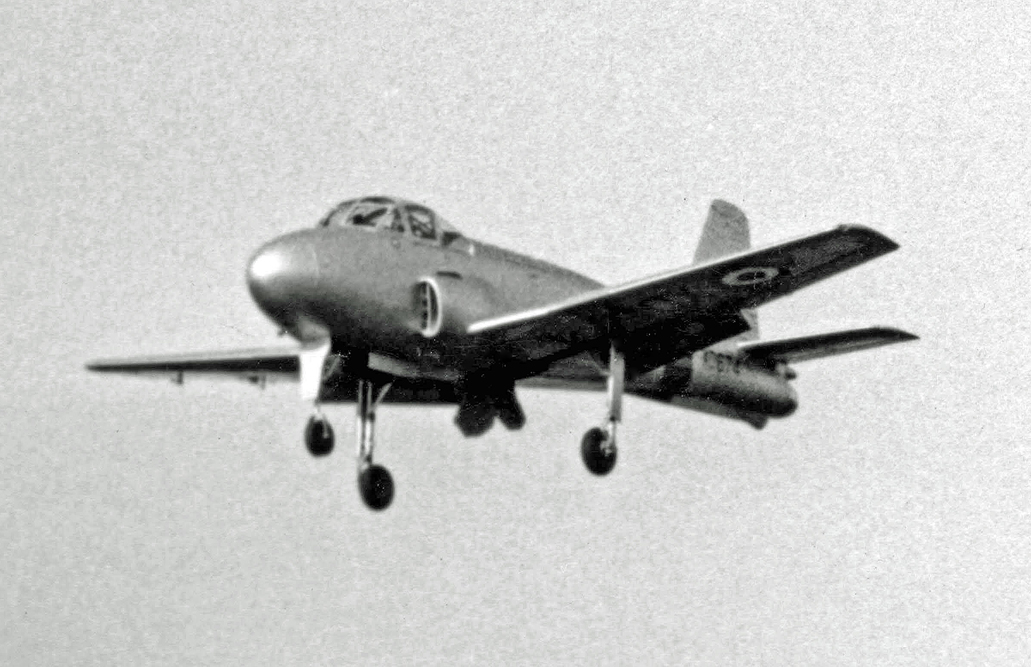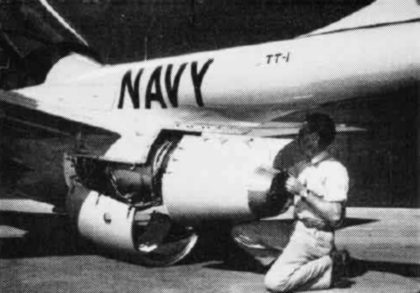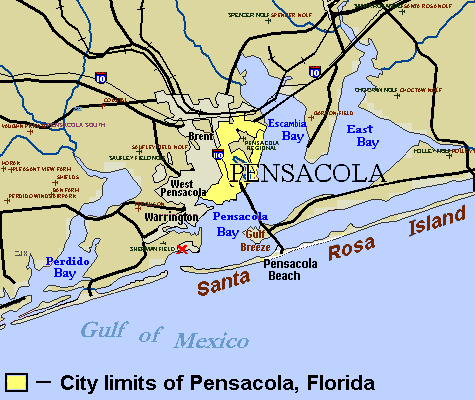|
Temco Pinto
The Temco TT Pinto is a tandem two-seat Trainer (aircraft), primary jet trainer built for the United States Navy by Temco Aircraft of Dallas, Texas. Design and development The Temco Model 51 had been initially proposed to the US Air Force in response to an Air Force competition for a jet-powered primary trainer, which was won by the Cessna T-37 Tweet. The concept behind the Model 51 was an attempt to provide primary training in a jet-powered aircraft. The official name for the Model 51 was the Pinto. The Pinto was a mid-wing, tricycle landing gear trainer with an enclosed cockpit powered by a single Continental Motors Company, Continental Motors J69-T-9 (license-built Turbomeca Marboré) jet engine. The aircraft carried no armament. The TT-1s were equipped with many of the same features found in operational jets, including ejection seats, liquid oxygen equipment, speed brakes, along with typical flight controls and instrument panels. Although the flight characteristics were co ... [...More Info...] [...Related Items...] OR: [Wikipedia] [Google] [Baidu] |
Trainer (aircraft)
A trainer is a class of aircraft designed specifically to facilitate flight training of pilots and aircrews. The use of a dedicated trainer aircraft with additional safety features—such as tandem flight controls, forgiving flight characteristics and a simplified cockpit arrangement—allows pilots-in-training to safely advance their skills in a more forgiving aircraft. Civilian pilots are normally trained in a light aircraft, with two or more seats to allow for a student and instructor. Tandem and side by side The two seating configurations for trainer aircraft are: pilot and instructor side by side, or in tandem, usually with the pilot in front and the instructor behind. The side-by-side seating configuration has the advantage that the pilot and instructor can see each other's actions, allowing the pilot to learn from the instructor and the instructor to correct the student pilot. The tandem configuration has the advantage of being closer to the normal working environment th ... [...More Info...] [...Related Items...] OR: [Wikipedia] [Google] [Baidu] |
American Jet Industries T-610 Super Pinto
The Temco TT Pinto is a tandem two-seat primary jet trainer built for the United States Navy by Temco Aircraft of Dallas, Texas. Design and development The Temco Model 51 had been initially proposed to the US Air Force in response to an Air Force competition for a jet-powered primary trainer, which was won by the Cessna T-37 Tweet. The concept behind the Model 51 was an attempt to provide primary training in a jet-powered aircraft. The official name for the Model 51 was the Pinto. The Pinto was a mid-wing, tricycle landing gear trainer with an enclosed cockpit powered by a single Continental Motors J69-T-9 (license-built Turbomeca Marboré) jet engine. The aircraft carried no armament. The TT-1s were equipped with many of the same features found in operational jets, including ejection seats, liquid oxygen equipment, speed brakes, along with typical flight controls and instrument panels. Although the flight characteristics were considered good, the "wave off" capability was ra ... [...More Info...] [...Related Items...] OR: [Wikipedia] [Google] [Baidu] |
Cessna A-37 Dragonfly
The Cessna A-37 Dragonfly, or Super Tweet, is a jet-powered, light attack aircraft designed and produced by the American aircraft manufacturer Cessna. It was developed during the Vietnam War in response to military interest in new counter-insurgency (COIN) aircraft to replace aging types such as the Douglas A-1 Skyraider. A formal United States Air Force (USAF) evaluation of the T-37 Tweet basic trainer for the COIN mission was conducted in late 1962, after which it was concluded that it could be modified to effectively perform the role. The attack-orientated A-37 was directly derived from the T-37, roughly doubling in both all-up weight and engine thrust to permit considerable quantities of munitions to be carried along with extended flight endurance and additional mission avionics. The prototype YAT-37D performed its maiden flight during October 1964. While test results were positive, a production contract was not immediately forthcoming until an uptick in combat intensi ... [...More Info...] [...Related Items...] OR: [Wikipedia] [Google] [Baidu] |
BAC Jet Provost
The BAC Jet Provost is a British jet trainer aircraft that was in use with the Royal Air Force (RAF) from 1955 to 1993. It was originally developed by Hunting Percival from the earlier piston engine-powered Percival Provost basic trainer, and later produced by the British Aircraft Corporation (BAC). In addition to the multiple RAF orders, the Jet Provost, sometimes with light armament, was exported to many air forces worldwide. The design was also further developed into a more heavily armed Attack aircraft, ground attack variant under the name BAC Strikemaster. Development Origins In early 1951, Hunting Percival began work on the design studies that would ultimately lead to the Jet Provost. At the time, the company was in the process of establishing mass production for the earlier Piston engine, piston-engined Percival Provost basic trainer, but had anticipated that demand for a jet-powered trainer aircraft would be on the horizon. The design team aimed to produce an aircraft ... [...More Info...] [...Related Items...] OR: [Wikipedia] [Google] [Baidu] |
Continental YJ69-T-9
The Teledyne CAE J69 was a small turbojet engine originally produced by Continental Aviation and Engineering (CAE) under license from Turbomeca. The J69 was a development of the Turbomeca Marboré II. It powered a number of U.S. drones, missiles and small aircraft. The engine was later produced by Teledyne CAE. The J69 was also developed into the Teledyne CAE J100 turbojet optimized for operation at higher altitudes. Variants ''Data from: ''Aircraft engines of the World 1957 ;J69-T-1: (Marboré I) at 23,000 rpm. ;J69-T-3: at 22,500 rpm for take-off. ;J69-T-6: ;J69-T-9: ;J69-T-17: ;J69-T-19: ;J69-T-19A: ;J69-T-19B: ;J69-T-23: ;J69-T-25: ;J69-T-27: ;J69-T-29: ;J69-T-31: ;J69-T-33: ;J69-T-39: ;J69-T-41: ;J69-T-41A: ;J69-T-406: ;J100-CA-100: thrust ;CJ69-1025: ;CJ69-1400: lb thrust ;Model 352: ;Model 352A: ;Model 352-5a: (CJ69-T-1025) thrust ;Model 354-12: (J69-T-27) thrust ;Model 356-7A: (J69-T-29) thrust ;Model 356-7D: (J69-T-29) thrust ;Model 356-8: (J69-T-31) thrust ... [...More Info...] [...Related Items...] OR: [Wikipedia] [Google] [Baidu] |
McDonnell Douglas
McDonnell Douglas Corporation was a major American Aerospace manufacturer, aerospace manufacturing corporation and defense contractor, formed by the merger of McDonnell Aircraft and the Douglas Aircraft Company in 1967. Between then and its own merger with Boeing in 1997, it produced well-known commercial and military aircraft, such as the McDonnell Douglas DC-10, DC-10 and the McDonnell Douglas MD-80, MD-80 airliners, the McDonnell Douglas F-15 Eagle, F-15 Eagle air superiority fighter, and the McDonnell Douglas F/A-18 Hornet, F/A-18 Hornet multirole combat aircraft, multirole fighter. The corporation's headquarters were at St. Louis Lambert International Airport, near St. Louis, Missouri. History Background The company was formed from the firms of James Smith McDonnell and Donald Wills Douglas, Sr., Donald Wills Douglas in 1967. Both men were of Scottish ancestry, were graduates of the Massachusetts Institute of Technology, and had worked for the aircraft manufacturer Glenn ... [...More Info...] [...Related Items...] OR: [Wikipedia] [Google] [Baidu] |
McDonnell Aircraft Corporation
The McDonnell Aircraft Corporation was an American aerospace manufacturer based in St. Louis, Missouri. The company was founded on July 6, 1939, by James Smith McDonnell, and was best known for its military fighters, including the F-4 Phantom II, and crewed spacecraft including the Mercury capsule and Gemini capsule. McDonnell Aircraft later merged with the Douglas Aircraft Company to form McDonnell Douglas in 1967. History James McDonnell founded J.S. McDonnell & Associates in Milwaukee, Wisconsin, in 1928 to produce a small aircraft for family use.J.S. McDonnell & Associates, Early years: 1927-1938 (part 1) , Boeing.com. The economic depression from 1929 ruined his plans and the company collapsed. He went to work for [...More Info...] [...Related Items...] OR: [Wikipedia] [Google] [Baidu] |
Turbojet
The turbojet is an airbreathing jet engine which is typically used in aircraft. It consists of a gas turbine with a propelling nozzle. The gas turbine has an air inlet which includes inlet guide vanes, a compressor, a combustion chamber, and a turbine (that drives the compressor). The compressed air from the compressor is heated by burning fuel in the combustion chamber and then allowed to expand through the turbine. The turbine exhaust is then expanded in the propelling nozzle where it is accelerated to high speed to provide thrust. Two engineers, Frank Whittle in the United Kingdom and Hans von Ohain in Germany, developed the concept independently into practical engines during the late 1930s. Turbojets have poor efficiency at low vehicle speeds, which limits their usefulness in vehicles other than aircraft. Turbojet engines have been used in isolated cases to power vehicles other than aircraft, typically for attempts on land speed records. Where vehicles are "turbine-powere ... [...More Info...] [...Related Items...] OR: [Wikipedia] [Google] [Baidu] |
Naval Air Training Command
The Naval Air Training Command (NATRACOM) is a one-star Echelon III command that conducts flight training of student Naval Aviators, student Naval Flight Officers and student Air Vehicle Pilots (AVP). Though it does not conduct Naval Aircrew training which is conducted by Naval Education and Training Command's Naval Aviation Schools Command (NASC), it is responsible for monitoring the production of Aircrewmen through the Naval Aviator Production Process (NAPP). Through the NAPP, NATRACOM is also responsible for programming and monitoring the production of all (currently 19) Navy and Marine Corps Fleet Replacement Squadrons. It conducts operations aboard five Naval Air Stations in three states. The Mission of Naval Air Training Command is to train the world’s finest combat quality aviation professionals, delivering them at the right time, in the right numbers, and at the right cost. Chief of Naval Air Training The Chief of Naval Air Training (CNATRA), currently RADM Richa ... [...More Info...] [...Related Items...] OR: [Wikipedia] [Google] [Baidu] |
Pensacola, Florida
Pensacola ( ) is a city in the Florida panhandle in the United States. It is the county seat and only incorporated city, city in Escambia County, Florida, Escambia County. The population was 54,312 at the 2020 United States census, 2020 census. It is the principal city of the Pensacola metropolitan area, which had 509,905 residents in the 2020 census. Pensacola was first settled by the Spanish Empire in 1559, antedating the establishment of St. Augustine, Florida, St. Augustine by six years, but was abandoned due to a significant hurricane and not resettled until 1698. Pensacola is a Port of Pensacola, seaport on Pensacola Bay, which is protected by the barrier island of Santa Rosa Island (Florida), Santa Rosa and connects to the Gulf of Mexico. A large Naval Air Station Pensacola, United States Naval Air Station, the first in the United States, is located in Pensacola. It is the base of the Blue Angels flight-demonstration team and the National Naval Aviation Museum. The Univers ... [...More Info...] [...Related Items...] OR: [Wikipedia] [Google] [Baidu] |
Temco TT-1 Pinto Head-on View
The Texas Engineering & Manufacturing Company (TEMCO), also known as Temco Aircraft Corporation, was a U.S.-based manufacturing company located in Dallas, Texas, USA. It is best known for eventually forming part of the conglomerate Ling-Temco-Vought. History Company formation Temco was the brainchild of Robert McCulloch, who began his career in aircraft with the Aircraft Division of William Beardmore and Company in Scotland. McCulloch emigrated to the US in 1927 and worked for a small machining company before joining the Atlantic Aircraft Corporation. The company was "flipped" a number of times during the Great Depression, first becoming Fokker Aircraft of America, then General Aviation, and finally North American Aviation (NAA), where McCulloch rose to become factory manager in 1941. That year he took a position at Convair as the general manager of their factory in Nashville, Tennessee, but he returned to NAA in 1943 and by the end of World War II was the manager of their new ... [...More Info...] [...Related Items...] OR: [Wikipedia] [Google] [Baidu] |









